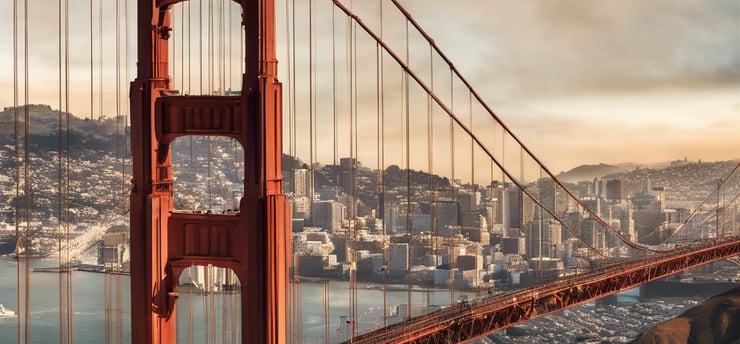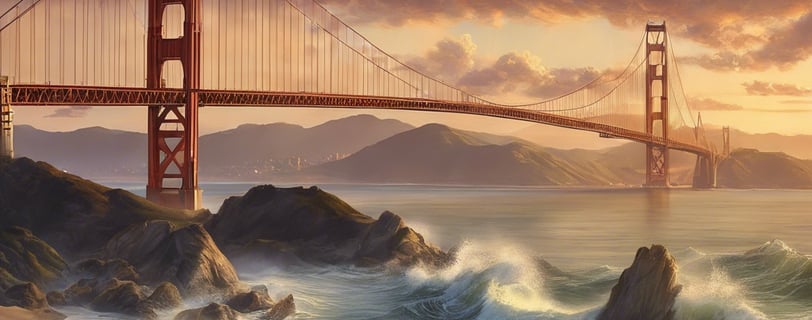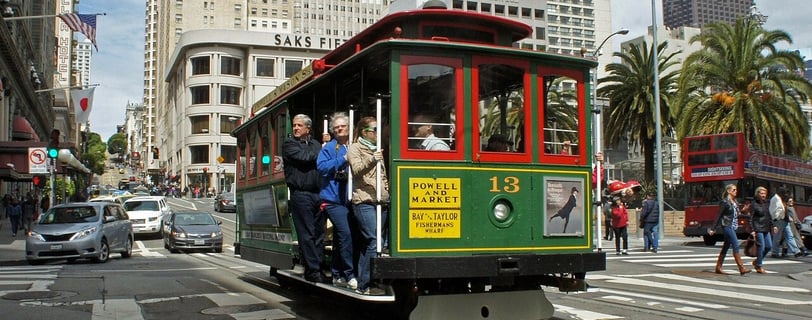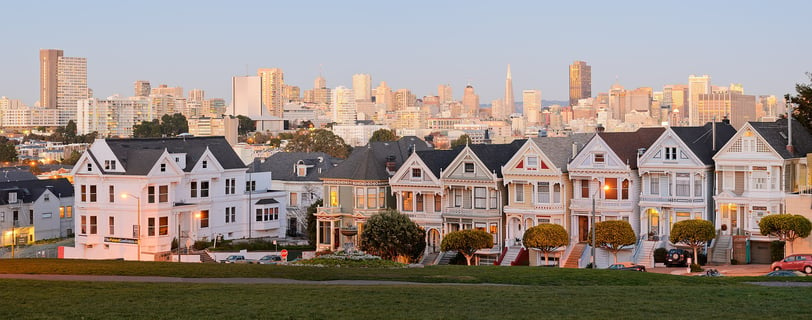Explore San Francisco: Top 10 Tourist Destinations and Best Places to Stay
Ready to explore the City by the Bay? Our guide will help you plan the perfect trip
SFTopNews: Sarah Keller
10/7/2024


San Francisco's Tourist Attractions
San Francisco, a city renowned for its iconic landmarks and vibrant culture, serves as a multifaceted travel destination that captivates millions of visitors each year. Nestled on the northern tip of the San Francisco Peninsula, the city boasts a rich history marked by significant events, diverse communities, and a dynamic arts scene. From its diverse neighborhoods to its historical significance, San Francisco offers a unique blend of attractions that cater to various interests and preferences.
The city is perhaps best known for its stunning landscapes, characterized by steep hills, picturesque waterfronts, and panoramic views of the Pacific Ocean. The Golden Gate Bridge stands as a symbol of engineering prowess and artistic beauty, while the colorful Victorian houses of Alamo Square showcase the city's architectural diversity. Visitors are often drawn to the vibrant essence of areas such as Chinatown, claimed to be the oldest and largest in North America, which presents an array of culinary delights and cultural experiences.
In addition to scenic vistas and cultural hubs, San Francisco's commitment to environmental sustainability and innovation adds to its allure. The city's numerous parks, including the expansive Golden Gate Park, provide residents and tourists alike with opportunities for recreation and leisure in a natural setting. Furthermore, various museums, historical sites, and entertainment venues enrich the experience for those eager to delve into the city's storied past and thriving present.
Given these captivating elements, San Francisco firmly establishes itself as a must-visit location. Its rich tapestry of attractions ensures that every traveler can find something to admire and enjoy. Prepare for an exploration of the top 10 tourist destinations that collectively showcase the charm and vibrancy of this exceptional city.


Golden Gate Bridge: An Iconic Landmark
The Golden Gate Bridge is undoubtedly one of the most recognized symbols of San Francisco and a marvel of modern engineering. Opened in 1937, the bridge spans approximately 1.7 miles across the Golden Gate Strait, connecting San Francisco to Marin County. Its suspension design, characterized by Art Deco elements, was revolutionary at the time of its construction and posed several engineering challenges that had to be surmounted by its visionary designers.
Construction of the Golden Gate Bridge commenced in 1933 amidst the Great Depression, representing a significant feat of urban resilience and innovation. The main challenge was to develop a bridge that could withstand the strong winds and fog that frequently envelop the strait. Design engineers Joseph Strauss, Leon Moisseiff, and Irving Morrow worked collaboratively to create a structure that would not only be functional but also aesthetically pleasing. The striking International Orange color was chosen to enhance visibility in the often foggy conditions and contribute to the bridge's iconic imagery.
This landmark has gained status as one of the most photographed sites globally, attracting millions of visitors each year. Its stunning vistas, particularly at sunrise and sunset, provide breathtaking backdrops, making it a favorite among photographers and tourists alike. The Golden Gate Bridge serves as both a practical thoroughfare for vehicles and pedestrians, as well as a symbol of the spirit of San Francisco. It projects a sense of connection, not just physically joining two locations, but also culturally embodying the aspiration and vision of the city as a whole.
Furthermore, the bridge is a testament to the technological advancements of its time and continues to represent the ingenuity of civil engineering. Over the decades, it has become an enduring symbol not only of San Francisco but also of determination and innovation, standing resilient in the face of the passage of time.


Alcatraz Island: A Historical Adventure
Alcatraz Island, famously known as "The Rock," is a pivotal piece of San Francisco's history. Originally established in the mid-1850s as a military fortification, its purpose transitioned significantly over the decades. By 1934, Alcatraz became a federal penitentiary, designed to hold some of the most notorious criminals of the time, including Al Capone and George "Machine Gun" Kelly. The island's remote location and fortified structures made it an ideal site for a high-security prison, adding to its infamous reputation.
The allure of Alcatraz extends beyond its architectural and historical significance. The island has a ghostly charm, drawing numerous visitors keen to uncover its haunting past. The eerie ambiance, coupled with the tales of infamous escape attempts, adds an air of intrigue. For example, the 1962 escape of Frank Morris alongside the Anglin brothers remains one of the most renowned attempts to flee the prison, involving a daring and elaborate plan that has captured the imaginations of many. Despite extensive measures put in place to prevent escapes, the trio’s fateful decision continues to spark curiosity and debate among historians and enthusiasts.
Visiting Alcatraz Island provides a unique perspective on American history, showcasing both the struggles and resilience displayed by its inhabitants. The now-abandoned prison in its dilapidated state offers guided tours that recount captivating stories of its past, providing insight into life on the island. Visitors can explore various exhibits, including original prison cells and the haunting isolation that prisoners faced. The comprehensive audio tour, featuring narratives from former inmates and guards, immerses guests in the challenges and harsh realities of life within these rugged walls. Alcatraz Island serves as a stark reminder of a significant chapter in the American criminal justice system, making it an essential stop for those


Fisherman’s Wharf: A Culinary and Cultural Hub
Fisherman’s Wharf stands as one of San Francisco's most iconic waterfront areas, offering a unique blend of culinary delights and cultural experiences. Originally established in the late 1800s as a vibrant fishing community, the Wharf has evolved into a premier tourist destination that attracts millions of visitors annually. Its rich maritime history is reflected in the many attractions that line the wharf, drawing both locals and tourists alike.
Today, Fisherman’s Wharf is renowned for its fresh seafood, with numerous restaurants and stalls offering delectable dishes such as clam chowder served in sourdough bread bowls, crab cocktails, and fish and chips. The picturesque waterfront setting enhances the culinary experience, as diners enjoy their meals with stunning views of the bay and the historic Pier 39. The area is also home to lively seafood markets where visitors can purchase the catch of the day, further celebrating San Francisco’s maritime heritage.
In addition to its gastronomic offerings, Fisherman’s Wharf boasts a variety of attractions that cater to diverse interests. From the lively street performers and vibrant festive atmosphere to the renowned sea lions lounging at Pier 39, there is no shortage of entertainment. A short stroll will lead you to attractions such as the Exploratorium, an interactive science museum, and the San Francisco Maritime National Historical Park, where visitors can explore beautifully preserved ships and learn about the city’s nautical history.
The combination of historical significance, culinary excellence, and a range of recreational activities makes Fisherman’s Wharf a cherished destination. The area's charm lies in its ability to provide something for everyone, ensuring that it remains a fundamental part of the San Francisco experience.
Chinatown: The Vibrant Chinese Cultural Experience
San Francisco's Chinatown stands as a remarkable testament to Chinese heritage and culture, making it the oldest and one of the largest Chinatowns in North America. Established in the 1840s, this vibrant neighborhood has evolved into a cultural hub that attracts millions of visitors each year. The significance of Chinatown extends beyond its geographical boundaries; it serves as a vital link to the Chinese diaspora, offering a glimpse into the rich traditions that Chinese immigrants have preserved through generations.
Walking through the streets of Chinatown, visitors are greeted with a sensory feast. The area is adorned with intricate architecture, featuring traditional Chinese motifs and colorful murals that narrate the stories of the community. Among the major attractions is the iconic Dragon Gate, which marks the entrance to the neighborhood and symbolizes protection and prosperity. Additionally, the bustling shops and markets showcase an assortment of authentic Chinese goods, from herbal medicines to handcrafted souvenirs, reflecting the area’s vibrant commerce.
Culinary explorations in Chinatown are essential to any visit. The district is renowned for its diverse and delectable cuisine, offering everything from dim sum to Peking duck. Notable eateries, such as the legendary Yank Sing and the bustling Good Mong Kok Bakery, have become culinary landmarks that provide visitors with a taste of traditional dishes. In addition, various festivals throughout the year—including the renowned Chinese New Year celebration—infuse the community with energy, featuring vibrant parades, lion dances, and cultural performances that highlight the richness of Chinese heritage.
Art is another vital aspect of Chinatown's cultural experience. Local galleries and cultural centers host exhibitions that showcase traditional and contemporary Chinese art, providing insight into the creativity that thrives within the community. In essence, visiting Chinatown is not merely a stroll through a neighborhood; it is an immersive experience that invites individuals to appreciate the multifaceted dimensions of Chinese culture through history, cuisine, art, and festivities.


Union Square: The Heart of Shopping and Entertainment
Union Square represents a quintessential aspect of San Francisco's urban landscape, renowned for its vibrant atmosphere and as a prime shopping destination. Originally developed in the mid-19th century, this public square was named to commemorate the Union during the American Civil War, serving as a gathering place for the community. Over time, it has transformed into a bustling hub, attracting shoppers, theatergoers, and culture enthusiasts from around the world.
The area surrounding Union Square boasts a diverse array of attractions, making it a key point of interest for both locals and tourists. Shopping enthusiasts can explore high-end retailers, boutique stores, and flagship locations from major brands. Notably, the iconic department stores and luxury boutiques line the streets, creating an unparalleled shopping experience that caters to various tastes and preferences. Furthermore, seasonal events and pop-up markets add to the allure, offering unique finds and local craftsmanship.
Apart from shopping, Union Square serves as a cultural epicenter with its proximity to several notable theaters, art galleries, and outdoor performances. The square frequently hosts art shows, live music events, and theatrical performances that celebrate the rich artistic heritage of San Francisco. Visitors can indulge in the vibrant nightlife, with numerous bars and restaurants nearby, showcasing diverse culinary options that reflect the city’s multicultural essence.
Accessibility plays a crucial role in Union Square's appeal. Strategically located, it is well-connected via public transportation, making it convenient for visitors to explore other attractions within the city. The harmonious blend of shopping, entertainment, and cultural richness establishes Union Square as a focal point in San Francisco, ensuring it remains an essential stop for millions each year
The Exploratorium: A Playground for Science Enthusiasts
The Exploratorium, situated on the Embarcadero in San Francisco, is not merely a museum; it is an interactive haven for science enthusiasts of all ages. Established in 1969 by physicist Frank Oppenheimer, the Exploratorium encourages exploration and hands-on learning through innovative exhibits designed to foster curiosity and understanding of the world around us. The museum's 600-plus exhibits cover a diverse range of topics, from biology and physics to art and human perception, making it an exemplary destination for visitors seeking an engaging educational experience.
One of the unique features of the Exploratorium is its commitment to blending science with art. Exhibits like the Tactile Dome challenge visitors to navigate through complete darkness using only their sense of touch, resulting in a compelling interaction between sensory experience and scientific inquiry. This ability to stimulate both the mind and the senses is a hallmark of the museum's approach, making it especially appealing to families and school groups. The hands-on nature of the exhibits encourages children and adults alike to ask questions, experiment, and learn in an engaging and playful environment.
The Exploratorium also places a strong emphasis on its educational mission. The institution frequently collaborates with educators to enhance science curricula in schools, making it a pivotal resource for group outings. The workshops and programs offered cater specifically to various age groups, ensuring each visitor leaves with valuable insights. The combination of interactive installations, artistic endeavors, and educational initiatives solidifies the Exploratorium's position as one of the premier tourist destinations in San Francisco, particularly for those passionate about science and learning.


Lombard Street and Coit Tower: Scenic Views and Unique Architecture
San Francisco is renowned for its unique architecture and breathtaking views, with Lombard Street and Coit Tower standing out as two of the city's most iconic landmarks. Lombard Street, often referred to as the "crookedest street in the world," is famous for its steep, winding turns and beautifully landscaped flower gardens. Constructed in 1922, this popular tourist destination was designed to reduce the steepness of the street’s incline, making it safer for vehicles and pedestrians. As visitors navigate its eight sharp turns, they can relish the stunning views of the surrounding cityscape and the lush greenery that adorns the street.
Coit Tower, a prominent structure located atop Telegraph Hill, is another must-see attraction in San Francisco. Completed in 1933, this neo-classical tower was built as a tribute to the city’s volunteer firefighters and showcases some of the finest murals from the Great Depression era. The murals depict various aspects of life in California, offering a cultural insight into the time period. Ascending the tower grants visitors unparalleled panoramic views of the Bay Area, making it a prime spot for photography and sightseeing. The intricate art and architectural features of Coit Tower highlight San Francisco’s commitment to preserving its history and arts.
Both Lombard Street and Coit Tower are essential stops for tourists keen on experiencing the city’s unique character. The combination of Lombard Street’s charming curves and Coit Tower’s historical significance provides a distinctive perspective of San Francisco. Exploring these destinations not only enhances one’s appreciation for the city’s rich architectural heritage but also offers visitors additional insight into its multifaceted history. You will find it worthwhile to include both landmarks on your itinerary while visiting the city.
Lombard Street and Coit Tower: Scenic Views and Unique Architecture
San Francisco is renowned for its unique architecture and breathtaking views, with Lombard Street and Coit Tower standing out as two of the city's most iconic landmarks. Lombard Street, often referred to as the "crookedest street in the world," is famous for its steep, winding turns and beautifully landscaped flower gardens. Constructed in 1922, this popular tourist destination was designed to reduce the steepness of the street’s incline, making it safer for vehicles and pedestrians. As visitors navigate its eight sharp turns, they can relish the stunning views of the surrounding cityscape and the lush greenery that adorns the street.
Coit Tower, a prominent structure located atop Telegraph Hill, is another must-see attraction in San Francisco. Completed in 1933, this neo-classical tower was built as a tribute to the city’s volunteer firefighters and showcases some of the finest murals from the Great Depression era. The murals depict various aspects of life in California, offering a cultural insight into the time period. Ascending the tower grants visitors unparalleled panoramic views of the Bay Area, making it a prime spot for photography and sightseeing. The intricate art and architectural features of Coit Tower highlight San Francisco’s commitment to preserving its history and arts.
Both Lombard Street and Coit Tower are essential stops for tourists keen on experiencing the city’s unique character. The combination of Lombard Street’s charming curves and Coit Tower’s historical significance provides a distinctive perspective of San Francisco. Exploring these destinations not only enhances one’s appreciation for the city’s rich architectural heritage but also offers visitors additional insight into its multifaceted history. You will find it worthwhile to include both landmarks on your itinerary while visiting the city.


The Painted Ladies: Tranquility Amidst the City’s Hustle
The Painted Ladies, a renowned row of Victorian houses located at Alamo Square, stand as a resplendent symbol of San Francisco’s architectural heritage. Built between 1892 and 1896, these homes exemplify the intricate design and ornate details characteristic of the Victorian style. With their vibrant colors and decorative facades, the Painted Ladies not only represent a significant period in American architecture but also serve as a visual delight for both locals and visitors. The houses are painted in a variety of pastel colors, which enhances their uniqueness and charm, making them a popular subject for photographers and artists alike.
The cultural impact of the Painted Ladies extends beyond their architectural beauty. They have been featured in numerous television shows, films, and advertisements, most notably in the opening credits of the beloved TV series "Full House." This portrayal has cemented their status in popular culture, drawing tourists from around the world who are eager to see the picturesque row of houses where the fictional Tanner family lived. The effortless blend of their historical significance and modern recognition makes the Painted Ladies a quintessential part of San Francisco's identity.
Beyond their aesthetic appeal, the Painted Ladies also serve as a reminder of the city’s resilience and commitment to preserving its history. In the face of urban development and modernization, these homes have remained intact, showcasing the city's dedication to maintaining its unique character. As you stand before the Painted Ladies, one can’t help but feel a sense of tranquility amid the bustling city life surrounding them. In a city known for its dynamic energy, these Victorian gems offer a moment of pause, a glimpse into the past, and a reminder of the beauty that can be found in the heart of urban landscapes.
Why You Should Visit San Francisco?
San Francisco stands out as a unique cultural and geographical gem on the West Coast of the United States. It offers an impressive array of attractions that cater to a diverse range of interests. From the breathtaking views atop Twin Peaks to the historic allure of Alcatraz Island, each destination within the city promises an unforgettable experience. Visitors can explore the vibrant arts scene in the Mission District, stroll through the iconic Golden Gate Park, or take a leisurely walk along the bustling waterfront at Fisherman’s Wharf. The city's rich history, diverse architecture, and stunning landscapes collectively contribute to its charm.
One of the most compelling reasons to visit San Francisco is its temperate climate. The best times to explore the city are typically during the spring and fall months. During these periods, the weather is mild, and visitors can enjoy outdoor activities without the summer crowds. However, it is worth noting that local events, such as the annual Folsom Street Fair or the San Francisco Pride Parade, offer unique experiences that could enhance one's visit, regardless of the season.
In addition to its landmarks, San Francisco's culinary scene is vibrant and exciting, offering everything from gourmet food trucks to Michelin-starred restaurants. The city's diverse neighborhoods each have their own distinct flavors and cuisines, encouraging food enthusiasts to embark on a culinary journey. This city is not only a visual feast but also a delight for the palate.
In conclusion, San Francisco is more than just a travel destination; it is an experience that encapsulates natural beauty, cultural diversity, and historical significance. Its top attractions and unique offerings make it a must-see for any traveler. Whether you’re seeking adventure, relaxation, or a cultural experience, San Francisco has something for everyone, inviting you to explore and discover its many wonders.
